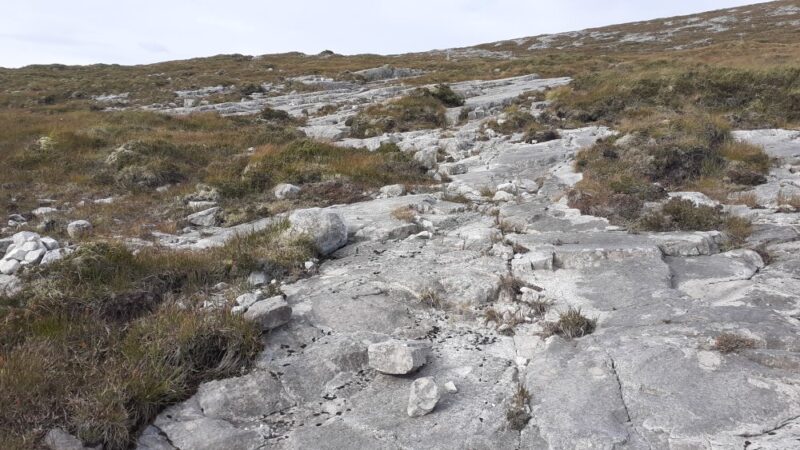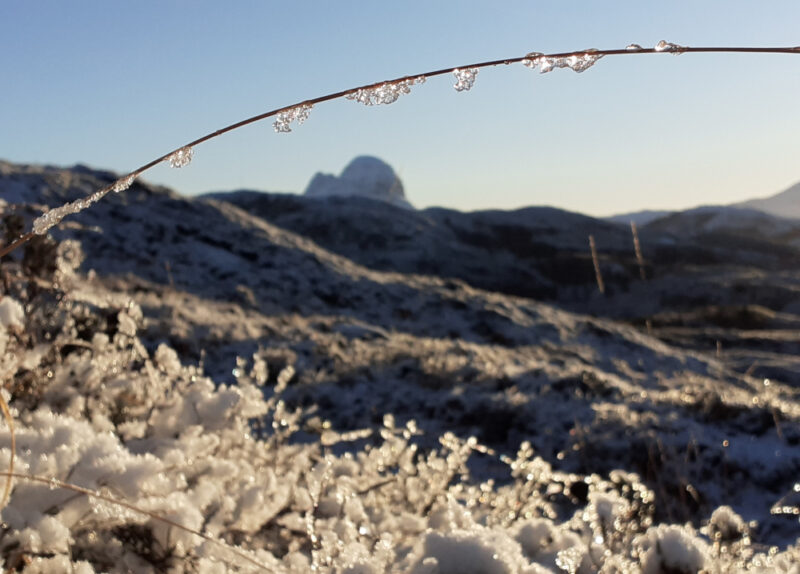flow
This is the greatest happiness, moving foot by foot over flowing rock. There’s so much of it, I’m spoilt, running upward and downward, alternating between following smooth tributaries and stravaiging over the wide plains of the full lithic flood.
And it is a flood, a huge bed of quartzite formed from the sands of an ancient seashore, deposited upon Torridonian sandstone, formed from the sands carried by ancient rivers which once flowed over the even more ancient bedrock of Lewisian gneiss. In the intervening millennia, this layered mountain mass has been repeatedly shaped and sculpted by ice and, although it’s been thousands of years since it was last glacially scoured, in places its faces glow like freshly scrubbed skin.
Not much grows on quartzite, so much of its surface is clean: it produces little soil and nutrition, and moss, grass and heather encroach only slowly. However, it’s its tone which brings it to life. It’s a pale stone, creamy-white, grey, or bluish, but is often stained with iron. The tenderness with which the iron tints it continually surprises me, from delicate tinges and marblings of peach and rose to bold stripes and swathes of thick mauve. I can’t help but lay my palms out along it, lie down on it, press myself into it.
I meander my way up the long slow slope to reach the bealach and sit on a flat stone in the largest of its shallow lochans. A huge blue-and-black-striped dragonfly beats around the reedy fringes. It’s so large its wings make a buzzing sound, like a miniature chainsaw cutting about, noisy even over the heavy drone of the bees. Although thinly grown, the quartzite is inhabited. Dor beetles are clambering about, humans too, hiking in serious silence or chatting breathlessly towards the summit, the odd dog scampering ahead. I let them all pass. I’m not going to the top today. Today is for communing with quartzite.
It’s technically not true metamorphic quartzite but quartz arenite, a sandstone comprised almost entirely of quartz, and it’s beautiful. Whatever I’m doing, out walking or building drystone walls, my eyes and hands and feet are drawn to it. It may be hereditary. Stonework runs in my dad’s side of the family, men from the three generations before his being stonemasons and quarry masters, building houses and roads across the Highlands and Perthshire. For a while, my great-grandfather built roads and airstrips with quartzite which he quarried near Onich.
I get up from the lochan and find a boulder to shelter behind. The stiff southerly wind holds a wintry coolness, carrying ravens and sea eagles, and whipping my whitening hair around my face. I find a slanted north-facing shelf and settle myself there, propping a flat stone with a couple of wedges to make a horizontal seat. From here, I look directly ahead to Arkle and Foinaven, the greatest of the quartzite mountains, an extensive complex of ridges with sweeping skirts of scree. I flew over all these mountains in a small plane on a clear winter’s day earlier this year. The sinuousness of their forms is much more apparent from the air as they curve and weave, rising and subsiding like petrified waves. This mountain I’m on now, Quinag, is also a beauty from above, its huge ridges and corries dropping away vertiginously at improbable angles.
What to do with it all? I’m always caught between flight and groundedness, between a rock and a high place. Maybe we all are, living somewhere in the in-between, in the alternation, rising and subsiding, passing through time.

Spidean Coinich, Quinag, Assynt, Scotland
5th September 2025







